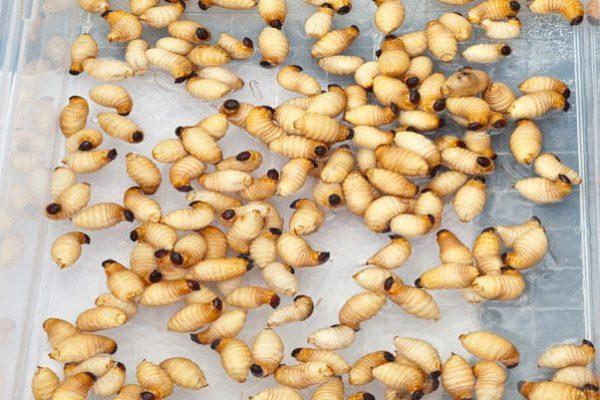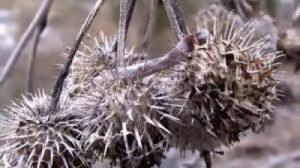Burdock moth: a pest that is beneficial
Content
Experienced fishermen know: burdock moth is a favorite delicacy of river fish. Such a "delicacy" will not be missed to taste perch, large roach, scavenger, ide, dace, silver bream. The bait can be bred at home or harvested from natural habitats. The burdock is distinguished by a good "catchability" on the first ice, in the dead of winter.
What does burdock moth look like (photo)
What is a burdock moth
Name: burdock moth
Latin: Triosa apicalis.Class: Insects - Insecta
Squad: Lepidoptera- homoptera
Family: butterfly of the genus Vanessa
 | Habitats: | burdock inflorescences |
 | Dangerous for: | not dangerous |
 | Means of destruction: | used as bait |
Adult insects settle on thick-stemmed weeds (burdock, wormwood, thistle). In the hollow vegetative part, adult insects lay eggs and produce "offspring".
Burdock moth larva - biological characteristics and habitats
The first groups of “settlers” appear in weed inflorescences at the end of summer, and in late autumn the stems represent entire farms for overwintering moth larvae. Visually, these are small spindle-shaped worms (1,5-3 mm in size) of cream or pale yellow color.
The body is crowned with a brown dot-head. In the stem, the larvae intensively feed on the soft core and juices of the plant. This is due to the specific smell that attracts fish to the burdock nozzle.
What are the advantages of burdock larvae when fishing
Moth is attractive to all river dwellers. Burdocks “showed” themselves well in reservoirs inhabited by different types of fish.
Inside the embryo there is an odorous substance that fish like. The bait with smell is useful in the winter season with oxygen deficiency. Here the burdock will certainly please the fisherman with a catch.
You can use the larva separately, in combination with bloodworms or maggots. Sometimes fishermen bait several larvae on a hook.
In what places can you find the larva of the burdock moth
You can find bait in weed thickets near ditches, hedges, in wastelands, near and vegetable gardens. Especially popular in fishing life are larvae extracted from burdocks, three types of larvae:
- Dried seedlings-cones of burdock. The eggs are in the thick of the thorns, the emerging embryos secrete gluten and create a protective shell. This type of bait is taken for breeding or immediately used for fishing.
- Burdock. The larvae nest in the stems. This is the most "catchy" yellowish burdock, with a dense and juicy body that retains its shape during storage. The bait is easily attached to the hook, does not spread.
- Wormwood stalks. Chernobyl grows throughout Russia, so finding colony masonry is easy. Wormwood larvae are large in size and do not freeze in severe frosts.
How to collect and extract larvae from plant materials
Worms are removed from the stems with a thin knife. A longitudinal incision is made on the stem. Active inhabitants try to fly out, but due to clumsiness they fall down. The rest are pulled out by hand, helping with tweezers. Glued seeds are found in burdock cones (squeeze the cone with your fingers). The natural "house" is durable: it will have to be separated with an awl.

Burdock larvae.
Storage of baits for fishing from burdock moth
If the larvae are harvested for future use:
- industrial washers. The container is filled with worms and placed in a cool place. Shelf life 14-20 days;
- handy containers. Suitable plastic packaging from sweets, kinder surprises. The larvae are mixed with starch. The bait will lie for 7-10 days;
- storage in burdock, stems. Balconies or loggias, garages, refrigerators are used.
Weed stalks are plucked before fishing. The pupae are taken out into a container that can be put in a pocket of clothes.
How to properly breed the embryos of burdock butterflies
The organization of the factory of burdock moth larvae begins with the collection of plant materials. Under the storage of the stems, you will need a glass container or food-grade plastic; the moth does not favor technical polymers. The plant is placed in a container, covered with a lid. The jar is placed in a dark, ventilated place and periodically ventilated. Room temperature + 15-25 degrees.
Conclusion
In the understanding of people, a moth is a butterfly that spoils a fur coat or makes cereals unusable. Almost all types of moths are harmful. But the burdock moth, on the contrary, does a great job. Fishermen know and respect the little fat worm that hungry fish love so much.
Previous